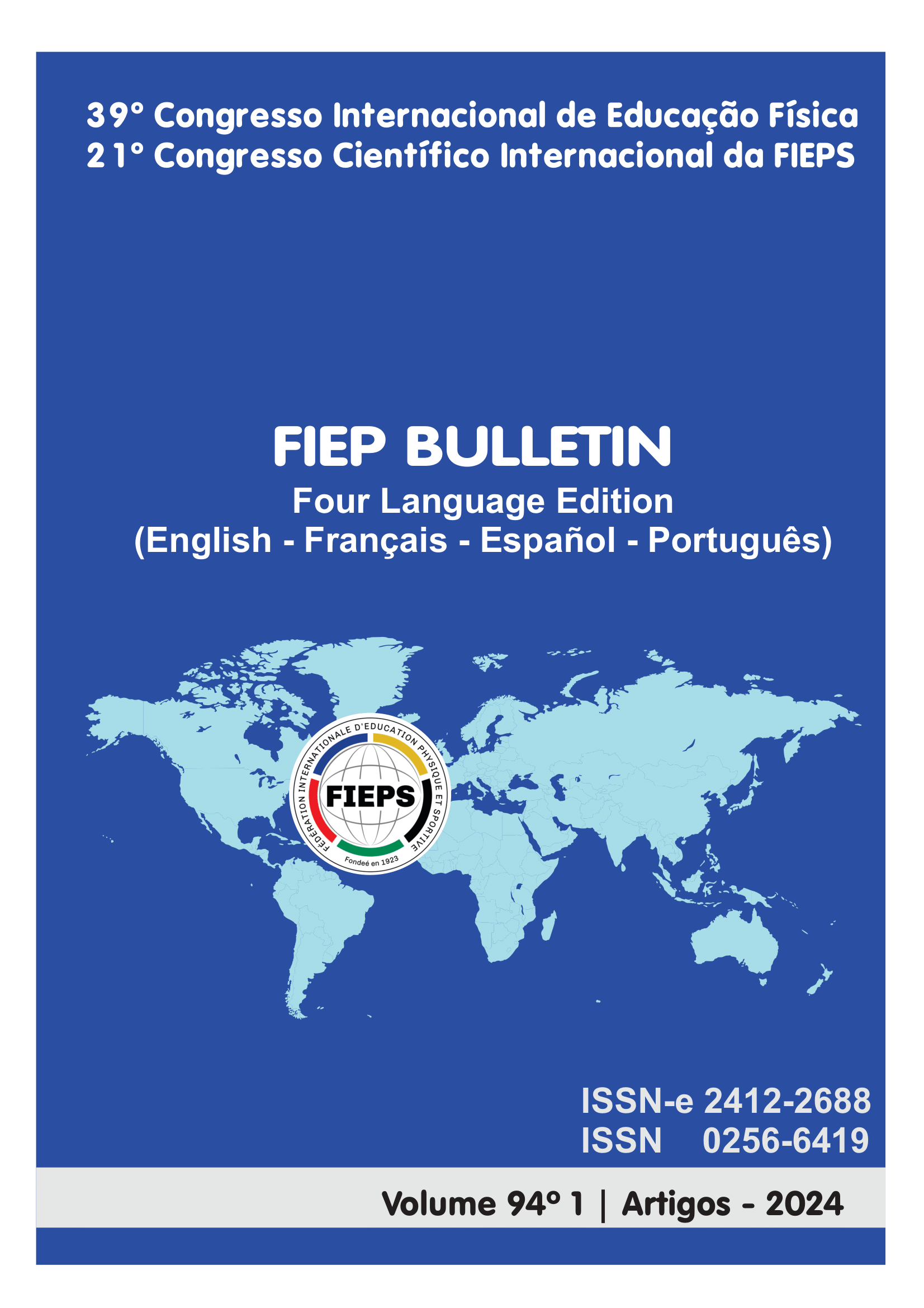BASES FISIOLÓGICAS DEL ENTRENAMIENTO PARA ATLETAS DE ATLETISMO DE MEDIA Y LONGA DISTANCIA: UNA BASE PARA PRESCRIBIR EL ENTRENAMIENTO PARA ATLETAS DE ORIENTACIÓN SPRINT
DOI:
https://doi.org/10.16887/fiepbulletin.v94i1.6795Resumen
La modalidad sprint del deporte de orientación es una prueba de duración media (12-15min) con picos de intensidad y consecuentemente variaciones en la demanda metabólica. La capacidad de reclutar específicamente la acción muscular sin reducir el rendimiento es crucial para el resultado final del atleta. La metodología de entrenamiento utilizada en esta modalidad debe considerar el metabolismo anaeróbico, incluso con menor participación durante todo el evento, como un factor importante limitante del rendimiento. A partir de esta observación, el presente estudio tuvo como objetivo evaluar la necesidad de utilizar formas de entrenamiento de media y larga distancia como base para los atletas en esta modalidad de sprint. La literatura disponible proporciona información importante basada en eventos de media y larga distancia, sin embargo existe un vacío importante respecto a los eventos de sprint. A pesar de esto, la información disponible contribuyó a demostrar que el metabolismo anaeróbico es un factor importante que determina el rendimiento. Se concluyó entonces que el programa de entrenamiento de la temporada deportiva debe incluir aspectos de entrenamiento anaeróbico con el objetivo de mejorar el rendimiento en eventos de orientación sprint, minimizando los efectos del aumento del lactato sanguíneo debido a los picos de intensidad y la variación
en la velocidad de carrera durante la prueba.
Descargas
Referencias
Almeida, R. A. C. d. S. d. (2011). "Análise preliminar da influência anaeróbia no desempenho de atletas de orientação." Fiep Bulletin - online 80(0).
Batista, M. M., A. C. Paludo, D. A. S. MP, M. V. Martins, P. H. Pauli, G. Dal'maz, J. M. Stefanello and M. P. Tartaruga (2021). "Effect of mental fatigue on performance, perceptual and physiological responses in orienteering athletes." J Sports Med Phys Fitness 61(5): 673-679. DOI: https://doi.org/10.23736/S0022-4707.21.11334-9
Billat, L. V. (2001). "Interval training for performance: a scientific and empirical practice. Special recommendations for middle- and long-distance running. Part I: aerobic interval training." Sports Med 31(1): 13-31. DOI: https://doi.org/10.2165/00007256-200131010-00002
Billat, L. V. (2001). "Interval training for performance: a scientific and empirical practice. Special recommendations for middle- and long-distance running. Part II: anaerobic interval training." Sports Med 31(2): 75-90. DOI: https://doi.org/10.2165/00007256-200131020-00001
Billat, L. V. and J. P. Koralsztein (1996). "Significance of the velocity at VO2max and time to exhaustion at this velocity." Sports Med 22(2): 90-108. DOI: https://doi.org/10.2165/00007256-199622020-00004
Bird, S. R., R. Bailey and J. Lewis (1993). "Heart rates during competitive orienteering." Br J Sports Med 27(1): 53-57. DOI: https://doi.org/10.1136/bjsm.27.1.53
Creagh, U. and T. Reilly (1997). "Physiological and biomechanical aspects of orienteering." Sports Med 24(6): 409-418. DOI: https://doi.org/10.2165/00007256-199724060-00005
Hébert-Losier, K., K. Jensen and H. C. Holmberg (2014). "Jumping and hopping in elite and amateur orienteering athletes and correlations to sprinting and running." Int J Sports Physiol Perform 9(6): 993-999.
Hébert-Losier, K., K. Jensen and H. C. Holmberg (2014). "Jumping and hopping in elite and amateur orienteering athletes and correlations to sprinting and running." Int J Sports Physiol Perform 9(6): 993-999. DOI: https://doi.org/10.1123/ijspp.2013-0486
Hébert-Losier, K., S. Platt and W. G. Hopkins (2015). "Sources of Variability in Performance Times at the World Orienteering Championships." Med Sci Sports Exerc 47(7): 1523-1530. DOI: https://doi.org/10.1249/MSS.0000000000000558
Johansson, C., L. Tsai, E. Hultman, R. Tegelman and A. Pousette (1990). "Restoration of anabolic deficit and muscle glycogen consumption in competitive orienteering." Int J Sports Med 11(3): 204-207. DOI: https://doi.org/10.1055/s-2007-1024792
Larsson, P., L. Burlin, E. Jakobsson and K. Henriksson-Larsén (2002). "Analysis of performance in orienteering with treadmill tests and physiological field tests using a differential global positioning system." J Sports Sci 20(7): 529-535. DOI: https://doi.org/10.1080/026404102760000035
Smekal, G., S. P. Von Duvillard, R. Pokan, K. Lang, R. Baron, H. Tschan, P. Hofmann and N. Bachl (2003). "Respiratory gas exchange and lactate measures during competitive orienteering." Med Sci Sports Exerc 35(4): 682-689. DOI: https://doi.org/10.1249/01.MSS.0000058358.14293.DE
Tønnessen, E., I. S. Svendsen, B. R. Rønnestad, J. Hisdal, T. A. Haugen and S. Seiler (2015). "The annual training periodization of 8 world champions in orienteering." Int J Sports Physiol Perform 10(1): 29-38. DOI: https://doi.org/10.1123/ijspp.2014-0005
Wakefield, B. R. and M. Glaister (2009). "Influence of work-interval intensity and duration on time spent at a high percentage of VO2max during intermittent supramaximal exercise." J Strength Cond Res 23(9): 2548-2554. DOI: https://doi.org/10.1519/JSC.0b013e3181bc19b1
Descargas
Publicado
Número
Sección
Licencia
Autores que publicam nesta revista concordam com os seguintes termos:- Autores mantém os direitos autorais e concedem à revista o direito de primeira publicação, com o trabalho simultaneamente licenciado sob a Licença Creative Commons Attribution que permite o compartilhamento do trabalho com reconhecimento da autoria e publicação inicial nesta revista.
- Autores têm autorização para assumir contratos adicionais separadamente, para distribuição não-exclusiva da versão do trabalho publicada nesta revista (ex.: publicar em repositório institucional ou como capítulo de livro), com reconhecimento de autoria e publicação inicial nesta revista.
- Autores têm permissão e são estimulados a publicar e distribuir seu trabalho online (ex.: em repositórios institucionais ou na sua página pessoal) a qualquer ponto antes ou durante o processo editorial, já que isso pode gerar alterações produtivas, bem como aumentar o impacto e a citação do trabalho publicado (Veja O Efeito do Acesso Livre).










